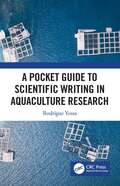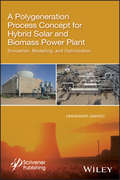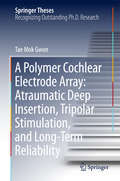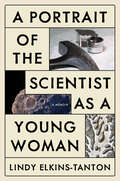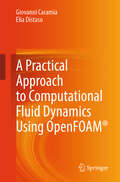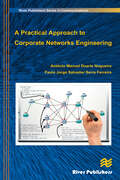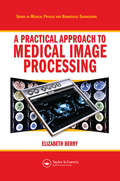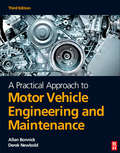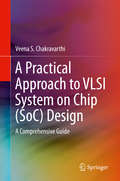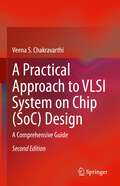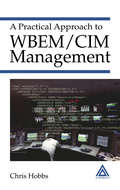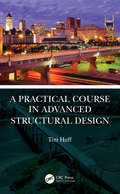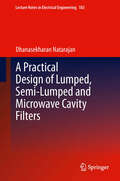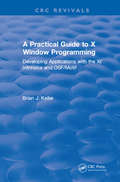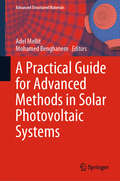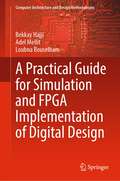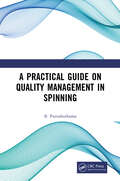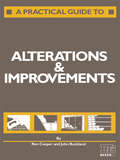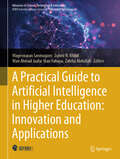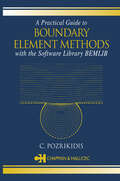- Table View
- List View
A Planet for the President
by Alistair BeatonThis is a story written over a decade ago.Before Fake News, or Alternative Facts, or even social media.It told the story of a not-too-distant future, which really was not too distant.*The President of the United States is facing a global catastrophe.The environment is in meltdown. People are dying. Americans are dying.Even he can't ignore it.There's hardly a corner of the world that isn't in crisis.And that's when he's persuaded of a truth his advisers hold to be self-evident: That it's time to think the unthinkable.The problem isn't power, or politics, or the planet, or the President.It's the People.*Hilarious and horrifying - this enormously entertaining satire has never been more razor-sharp, revelatory or relevant. What readers are saying about this hilarious, critically acclaimed novel:'For anyone who likes laughs and thrills in one package and who's been following recent developments in the White House this is an absolute must.' Amazon Reviewer, 5 stars'This political and satirical novel manages to be both thrilling and funny. And, given its prescience, scary too. The characters, the setting and the plot are fantastic and believable. A real page turner.' Amazon Reviewer,5 stars'A frighteningly plausible thriller, which imagines what might happen if the White House were finally to believe that something had to be done about global warming ... clever, funny and a really good read.' Amazon Reviewer, 5 stars'This thriller is packed with good jokes and tells a tale that is utterly credible. Parts were jaw-droppingly frightening and I wished I could have put it down but thesharp humour and pacey plot made me keep reading. It's a laugh and a chiller in one book.' Amazon Reviewer,5 stars
A Planet for the President: A Novel
by Alistair Beaton'For anyone who likes laughs and thrills in one package and who's been following recent developments in the White House this is an absolute must.' Amazon Reviewer, 5 starsIt is the near future and things are not going well for the President of the United States. He wants Americans to be adored by everyone but half the planet seems to be in a permanent state of insurrection against US power. What's more, there's a growing environmental crisis that even he can't ignore. It's one thing when there are floods in Bangladesh, quite another when almost 2,000 Americans die in flooding in Texas.His advisers warn him he could be remembered as the President who wrecked the planet.The President is persuaded of one simple fact: there are too many people in the world. Only radical action can deal with the problem. His advisors come up with a solution more ruthless than anything ever contemplated before. Appalled, the president refuses to go along with their plan.But it isn't long before he is committed to thinking the unthinkable ...****************What readers are saying about this hilarious, critically acclaimed novel:'This political and satirical novel manages to be both thrilling and funny. And, given its prescience, scary too. The characters, the setting and the plot are fantastic and believable. A real page turner.' Amazon Reviewer, 5 stars'A frighteningly plausible thriller, which imagines what might happen if the White House were finally to believe that something had to be done about global warming ... clever, funny and a really good read.' Amazon Reviewer, 5 stars'This thriller is packed with good jokes and tells a tale that is utterly credible. Parts were jaw-droppingly frightening and I wished I could have put it down but thesharp humour and pacey plot made me keep reading. It's a laugh and a chiller in one book.' Amazon Reviewer,5 stars
A Pocket Guide to Scientific Writing in Aquaculture Research
by Rodrigue YossaWriting for a high-quality scientific aquaculture publication is challenging, and many students and early career aquaculture scientists find the task daunting. Expanding on his popular workshop on Improving Scientific Writing at the 2017 World Aquaculture conference, Rodrigue Yossa provides new researchers with all the tools they need to write abstracts and a variety of articles (original, research reports, magazines, working papers, conference proceedings and more). He also takes the reader step-by-step through the process of reviewing submitted manuscripts and replying to reviewers, as well as understanding research ethics. Each section is accompanied by examples, and attention is focused on providing advice on grammar, how to focus your paper and possible loopholes when writing. A Pocket Guide to Scientific Writing in Aquaculture Research offers a lifeline to aquaculture students and early career researchers getting a grasp on the basics of science communication through writing.
A Policy Analysis of Reserve Retirement Reform
by James Hosek Beth J. Asch Michael G. MattockAs the defense burden borne by reserve forces has increased, more attention has been paid to differences between retirement systems for the reserve and active components. This report analyzes the systems, discusses the importance of structuring compensation to enable management flexibility, considers obstacles and how they might be overcome, and provides a quantitative assessment of the reserve retention and cost effects of possible proposals.
A Polygeneration Process Concept for Hybrid Solar and Biomass Power Plant: Simulation, Modelling, and Optimization
by Umakanta SahooThe global warming phenomenon as a significant sustainability issue is gaining worldwide support for development of renewable energy technologies. The term “polygeneration” is referred to as “an energy supply system, which delivers more than one form of energy to the final user.” For example, electricity, cooling and desalination can be delivered from a polygeneration process. The polygeneration process in a hybrid solar thermal power plant can deliver electricity with less impact on the environment compared to a conventional fossil fuel-based power generating system. It is also THE next generation energy production technique with the potential to overcome the undesirable intermittence of renewable energy systems. In this study, the polygeneration process simultaneous production of power, vapor absorption refrigeration (VAR) cooling and multi-effect humidification and dehumidification (MEHD) desalination system from different heat sources in hybrid solar-biomass (HSB) system with higher energy efficiencies (energy and exergy), primary energy savings (PES) and payback period are investigated, focusing on several aspects associated with hybrid solar-biomass power generation installations, such as wide availability of biomass resources and solar direct normal irradiance (DNI), and other technologies. Thermodynamic evaluation (energy and exergy) of HSB power has also been investigated, along with the VAR cooling system, the modelling, simulation, optimization and cost analysis of the polygeneration hybrid solar biomass system, all accompanied by multiple case studies and examples for practical applications. This volume provides the researcher, student and engineer with the intellectual tool needed for understanding new ideas in this rapidly emerging field. The book is also intended to serve as a general source and reference book for the professional (consultant, designer, contractor etc.) who is working in the field of solar thermal, biomass, power plant, polygeneration, cooling and process heat. It is a must-have for anyone working in this field.
A Polymer Cochlear Electrode Array: Atraumatic Deep Insertion, Tripolar Stimulation, and Long-Term Reliability (Springer Theses)
by Tae Mok GwonThis book describes the design, fabrication and evaluation of a polymer-based neural interface for a cochlear electrode array, reviewed in terms of fabrication process, functionality, and reliability. Polymer-based devices have attracted attention in the neural prosthetic field due to their flexibility and compatibility with micro-fabrication process. A liquid crystal polymer (LCP) is an inert, highly water-resistant polymer suitable for the encapsulation of electronic components and as a substrate material for fabricating neural interfaces. The author has designed, fabricated, and evaluated an LCP-based cochlear electrode array for an improved polymer-based cochlear implant. The thesis deals with 3 key topics: atraumatic deep insertion, tripolar stimulation, and long-term reliability. Atraumatic insertion of the intracochlear electrode and resulting preservation of residual hearing have become essential in state–of-the-art cochlear implantation. A novel tapered design of an LCP-based cochlear electrode array is presented to meet such goals. For high-density and pitch-recognizable cochlear implant, channel interaction should be avoided. Local tripolar stimulation using multi-layered electrode sites are shown to achieve highly focused electrical stimulation. This thesis addresses another vital issue in the polymer-based neural implants: the long-term reliability issue. After suggesting a new method of forming mechanical interlocking to improve polymer-metal adhesion, the author performs accelerating aging tests to verify the method’s efficacy. The aforementioned three topics have been thoroughly examined through various in vitro and in vivo studies. Verification foresees the development of LCP-based cochlear electrode array for an atraumatic deep insertion, advanced stimulation, and long-term clinical implant.
A Portrait of the Scientist as a Young Woman: A Memoir
by Lindy Elkins-Tanton"Fierce, absorbing, and ultimately inspiring." —ELIZABETH KOLBERT"One of the finest scientific memoirs ever written." —DAVID W. BROWNFrom one of the world’s leading planetary scientists, a luminous memoir of exploration on Earth, in space, and within oneself—equal parts ode to the beauty of science, meditation on loss, and roadmap for personal resilienceDeep in the asteroid belt between Mars and Jupiter, three times farther from the sun than the Earth is, orbits a massive asteroid called (16) Psyche. It is one of the largest objects in the belt, potentially containing the equivalent of the world’s total economy in metals, though they cannot be brought back to Earth. But (16) Psyche has the potential to unlock something even more valuable: the story of how planets form, and how our planet formed. Soon we will find out, thanks to the extraordinary work of Lindy Elkins-Tanton, the Principal Investigator of NASA’s $800 million Psyche mission, and the second woman ever to be awarded a major NASA space exploration contract.The journey that brought her to this place is extraordinary. Amid a childhood of terrible trauma, Elkins-Tanton fell in love with science as a means of healing and consolation. But still she wondered, was forced to wonder: as a woman, was science “for her”? In answering that question, she takes us from the wilds of the Siberian tundra to the furthest reaches of outer space, from the Mayo Clinic, where Elkins-Tanton battled ovarian cancer while writing the Psyche proposal, to NASA’s Jet Propulsion Laboratory, where her team brought that proposal to life.A Portrait of the Scientist as a Young Woman is a beautifully-constructed memoir that explores how a philosophy of life can be built from the tools of scientific inquiry. It teaches us how to approach difficult problems by asking the right questions and truly listening to the answers—and how we may find meaning through exploring the wonders of the universe around us.
A Practical Approach to Computational Fluid Dynamics Using OpenFOAM®
by Giovanni Caramia Elia DistasoThis book is designed for undergraduate and graduate engineering students who are encountering computational fluid dynamics for the first time in their study of fluid machines. The approach emphasizes a gradual and effective learning process, aiming to minimize the time required to attain a solid foundational understanding. Clarity of exposition is prioritized over strict mathematical rigor, with continuous reference to the physical significance of the mathematical formulas presented. This approach enables students to independently produce acceptable results for most case studies of general interest. The book provides a comprehensive collection of essential concepts needed for correctly configuring any computational fluid dynamics software. To enhance accessibility, it focuses on OpenFOAM, a free and open-source software renowned for its extensive community of developers and users.
A Practical Approach to Corporate Networks Engineering
by Paulo Salvador Antonio NogueiraA Practical Approach to Corporate Networks Engineering is dedicated to corporate network design and engineering, covering the different levels of network design and deployment. The main theoretical concepts are explained and the different functioning mechanisms are illustrated with practical experiments. Using an open source network simulator that is able to emulate real network equipment and run concrete network scenarios (Graphical Network Simulator), the authors present several realistic network scenarios that illustrate the different network protocols and mechanisms and can be easily replicated by readers at home. Readers will be able to configure the different network equipments, run the scenarios and capture traffic at the different network links on their own, ordinary PC, acquiring a deep knowledge of the underlying network protocols and mechanisms.This interactive and practical teaching approach is very motivating and effective, since students can easily follow the explanations that are given throughout the book, making this work a valuable addition to the existing literature.
A Practical Approach to Medical Image Processing
by Elizabeth BerryThe ability to manipulate and analyze pictorial information to improve medical diagnosis, monitoring, and therapy via imaging is a valuable tool that every professional working in radiography, medical imaging, and medical physics should utilize. However, previous texts on the subject have only approached the subject from a programming or computer s
A Practical Approach to Metaheuristics using LabVIEW and MATLAB® (Chapman & Hall/CRC Computer and Information Science Series)
by Pedro Ponce-Cruz Arturo Molina Gutiérrez Ricardo A. Ramírez-Mendoza Efraín Méndez Flores Alexandro Antonio Espinoza David Christopher SilvaMetaheuristic optimization has become a prime alternative for solving complex optimization problems in several areas. Hence, practitioners and researchers have been paying extensive attention to those metaheuristic algorithms that are mainly based on natural phenomena. However, when those algorithms are implemented, there are not enough books that deal with theoretical and experimental problems in a friendly manner so this book presents a novel structure that includes a complete description of the most important metaheuristic optimization algorithms as well as a new proposal of a new metaheuristic optimization named earthquake optimization. This book also has several practical exercises and a toolbox for MATLAB® and a toolkit for LabVIEW are integrated as complementary material for this book. These toolkits allow readers to move from a simulation environment to an experimentation one very fast. This book is suitable for researchers, students, and professionals in several areas, such as economics, architecture, computer science, electrical engineering, and control systems. The unique features of this book are as follows: Developed for researchers, undergraduate and graduate students, and practitioners A friendly description of the main metaheuristic optimization algorithms Theoretical and practical optimization examples A new earthquake optimization algorithm Updated state-of-the-art and research optimization projects The authors are multidisciplinary/interdisciplinary lecturers and researchers who have written a structure-friendly learning methodology to understand each metaheuristic optimization algorithm presented in this book.
A Practical Approach to Motor Vehicle Engineering and Maintenance
by Allan Bonnick Derek NewboldFully updated and in line with latest specifications, this textbook integrates vehicle maintenance procedures, making it the indispensable first classroom and workshop text for all students of motor vehicle engineering, apprentices and keen amateurs. Its clear, logical approach, excellent illustrations and step-by-step development of theory and practice make this an accessible text for students of all abilities.With this book, students have information that they can trust because it is written by an experienced practitioner and lecturer in this area. This book will provide not only the information required to understand automotive engines but also background information that allows readers to put this information into context.The book contains flowcharts, diagnostic case studies, detailed diagrams of how systems operate and overview descriptions of how systems work. All this on top of step-by-step instructions and quick reference tables. Readers won't get bored when working through this book with questions and answers that aid learning and revision included.
A Practical Approach to VLSI System on Chip (SoC) Design: A Comprehensive Guide
by Veena S. ChakravarthiThis book provides a comprehensive overview of the VLSI design process. It covers end-to-end system on chip (SoC) design, including design methodology, the design environment, tools, choice of design components, handoff procedures, and design infrastructure needs. The book also offers critical guidance on the latest UPF-based low power design flow issues for deep submicron SOC designs, which will prepare readers for the challenges of working at the nanotechnology scale. This practical guide will provide engineers who aspire to be VLSI designers with the techniques and tools of the trade, and will also be a valuable professional reference for those already working in VLSI design and verification with a focus on complex SoC designs.A comprehensive practical guide for VLSI designers;Covers end-to-end VLSI SoC design flow;Includes source code, case studies, and application examples.
A Practical Approach to VLSI System on Chip (SoC) Design: A Comprehensive Guide
by Veena S. ChakravarthiNow in a thoroughly revised second edition, this practical practitioner guide provides a comprehensive overview of the SoC design process. It explains end-to-end system on chip (SoC) design processes and includes updated coverage of design methodology, the design environment, EDA tool flow, design decisions, choice of design intellectual property (IP) cores, sign-off procedures, and design infrastructure requirements. The second edition provides new information on SOC trends and updated design cases. Coverage also includes critical advanced guidance on the latest UPF-based low power design flow, challenges of deep submicron technologies, and 3D design fundamentals, which will prepare the readers for the challenges of working at the nanotechnology scale. A Practical Approach to VLSI System on Chip (SoC) Design: A Comprehensive Guide, Second Edition provides engineers who aspire to become VLSI designers with all the necessary information and details of EDA tools. It will be a valuable professional reference for those working on VLSI design and verification portfolios in complex SoC designs
A Practical Approach to WBEM/CIM Management
by Chris HobbsSystem architects and engineers in fields such as storage networking, desktop computing, electrical power distribution, and telecommunications need a common and flexible way of managing heterogeneous devices and services. Web-Based Enterprise Management (WBEM) and its Component Information Model (CIM) provide the architecture, language, interfaces,
A Practical Course in Advanced Structural Design
by Tim HuffA Practical Course in Advanced Structural Design is written from the perspective of a practicing engineer, one with over 35 years of experience, now working in the academic world, who wishes to pass on lessons learned over the course of a structural engineering career. The book covers essential topics that will enable beginning structural engineers to gain an advanced understanding prior to entering the workforce, as well as topics which may receive little or no attention in a typical undergraduate curriculum. For example, many new structural engineers are faced with issues regarding estimating collapse loadings during earthquakes and establishing fatigue requirements for cyclic loading – but are typically not taught the underlying methodologies for a full understanding. Features: Advanced practice-oriented guidance on structural building and bridge design in a single volume. Detailed treatment of earthquake ground motion from multiple specifications (ASCE 7-16, ASCE 4-16, ASCE 43-05, AASHTO). Details of calculations for the advanced student as well as the practicing structural engineer. Practical example problems and numerous photographs from the author’s projects throughout. A Practical Course in Advanced Structural Design will serve as a useful text for graduate and upper-level undergraduate civil engineering students as well as practicing structural engineers.
A Practical Design of Lumped, Semi-lumped & Microwave Cavity Filters (Lecture Notes in Electrical Engineering #183)
by Dhanasekharan NatarajanThis book presents the application of microwave literature for designing lumped/semi-lumped filters and combline/iris-coupled microwave cavity filters. It provides the physical understanding of the terms and characteristics of radio frequency (RF) filters. The book complements engineering text books on RF components and provides support for the project assignments of students. In addition to the functional design of RF filters, the integrated design approach for produceability and reliability is explained.
A Practical Guide To X Window Programming: Developing Applications with the XT Intrinsics and OSF/Motif
by Brian J. KellerA Practical Guide to X Window Programming is a basic guide that takes readers step by step through developing applications using X-Windows. The book covers the Xt Intrinsics portion of the X-Window system in detail and discusses the MIT Athena and OSF/Motif Widget Sets that are used in many of the examples. Topics covered include C programming fundamentals, text handling using X, fonts, event handling in Xt, extending the Widget Sets (building on Field Editor Widget), designing and constructing an application, building menus, printing help, OSF/Motif (including the window arranger) and interclient communication. Three extensive appendices are included: Widgets, Classing, and Exported Functions; Quick Xt Reference Guide (X11R4); and Quick Guide to OSF/Motif Widgets. Any applications designer interested in developing applications with Xt will find this book a valuable and enlightening resource.
A Practical Guide for Advanced Methods in Solar Photovoltaic Systems (Advanced Structured Materials #128)
by Adel Mellit Mohamed BenghanemThe present book focuses on recent advances methods and applications in photovoltaic (PV) systems. The book is divided into two parts: the first part deals with some theoretical, simulation and experiments on solar cells, including efficiency improvement, new materials and behavior performances. While the second part of the book devoted mainly on the application of advanced methods in PV systems, including advanced control, FPGA implementation, output power forecasting based artificial intelligence technique (AI), high PV penetration, reconfigurable PV architectures and fault detection and diagnosis based AI. The authors of the book trying to show to readers more details about some theoretical methods and applications in solar cells and PV systems (eg. advanced algorithms for control, optimization, power forecasting, monitoring and fault diagnosis methods). The applications are mainly carried out in different laboratories and location around the world as projects (Algeria, KSA, Turkey, Morocco, Italy and France). The book will be addressed to scientists, academics, researchers and PhD students working in this topic. The book will help readers to understand some applications including control, forecasting, monitoring, fault diagnosis of photovoltaic plants, as well as in solar cells such as behavior performances and efficiency improvement. It could be also be used as a reference and help industry sectors interested by prototype development.
A Practical Guide for Simulation and FPGA Implementation of Digital Design (Computer Architecture and Design Methodologies)
by Bekkay Hajji Adel Mellit Loubna BouselhamThis book introduces the FPGA technology used in the laboratory sessions, and provides a step-by-step guide for designing and simulation of digital circuits. It utilizes the VHDL language, which is one of the most common language used to describe the design of digital systems. The Quartus II, Xilinx ISE 14.7 and ModelSim software are used to process the VHDL code and make simulations, and then the Altera and Xilinx FPGA platforms are employed to implement the simulated digital designs. The book is composed of four parts. The first part of this book has two chapters and covers various aspects: FPGA architectures, ASIC vs FPGA comparison, FPGA design flow and basic VHDL concepts necessary to describe the design of digital systems. The second part of the book includes three chapters that deal with the design of digital circuits such as combinational logic circuits, sequential logic circuits and finite state machines. The third part of the book is reserved for laboratory projects carried out on the FPGA platform. It is a largely hands-on lab class for design digital circuits and implementing their designs on the Altera FPGA platform. Finally, the fourth part of this work is devoted to recent applications carried out on FPGAs, in particular advanced techniques in renewable energy systems. The book is primarily intended for students, scholars, and industrial practitioners interested in the design of modern digital systems.
A Practical Guide on Quality Management in Spinning
by B. PurushothamaThis book is a hands-on guide that discusses quality management in spinning. It details the techniques, insights and best practices that weave excellence into every fiber. The subject matter of this book discusses the concepts of product objectives and the impact of product features at customer’s end with examples.Print edition not for sale in South Asia (India, Sri Lanka, Nepal, Bangladesh, Pakistan and Bhutan)
A Practical Guide to Alterations and Improvements
by R. Cooper J. Buckland Mrs B CooperA practical guide which enables small builders to tackle everyday alteration and improvement projects with confidence.
A Practical Guide to Artificial Intelligence in Higher Education: Innovation and Applications (Advances in Science, Technology & Innovation)
by Mageswaran Sanmugam Zuheir N. Khlaif Wan Ahmad Jaafar Wan Yahaya Zaleha AbdullahThis book explains how educators can use artificial intelligence in education to enhance student engagement and improve learning outcomes by sharing best practices for using AI to enhance learning quality and foster sustainable teaching. This book covers various topics related to the use of AI in education, from designing activities to using AI in teaching to using AI in assessment by following the ethical considerations of using AI in teaching. The book not only discusses the related topics to using AI in education, but also presents best practices of using AI in teaching and learning from different countries and provides best practices of ethical considerations based on lives experiences of the authors. Furthermore, the book introduces the teaching methods of integrating AI in teaching and learning. Therefore, this book offers essential information and a practical guide to using AI in education.
A Practical Guide to Borehole Geophysics in Environmental Investigations
by W. Scott KeysBorehole geophysics is frequently applied in hydrogeological environmental investigations where, for example, sites must be evaluated to determine the distribution of contaminants. It is a cost-effective method for obtaining information during several phases of such investigations. Written by one of world's leading experts in the field, A Practical Guide to Borehole Geophysics in Environmental Investigations explains the basic principles of the many tools and techniques used in borehole logging projects. Applications are presented in terms of broad project objectives, providing a hands-on guide to geophysical logging programs, including specific examples of how to obtain and interpret data that meet particular hydrogeologic objectives.
A Practical Guide to Boundary Element Methods with the Software Library BEMLIB
by C. PozrikidisThe boundary-element method is a powerful numerical technique for solving partial differential equations encountered in applied mathematics, science, and engineering. The strength of the method derives from its ability to solve with notable efficiency problems in domains with complex and possibly evolving geometry where traditional methods can be d

